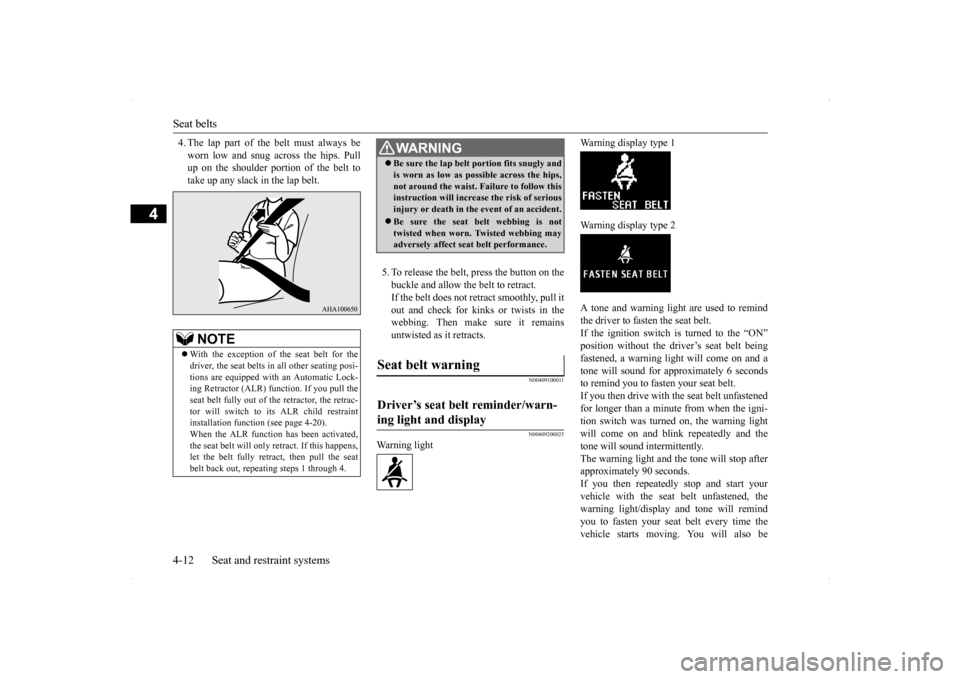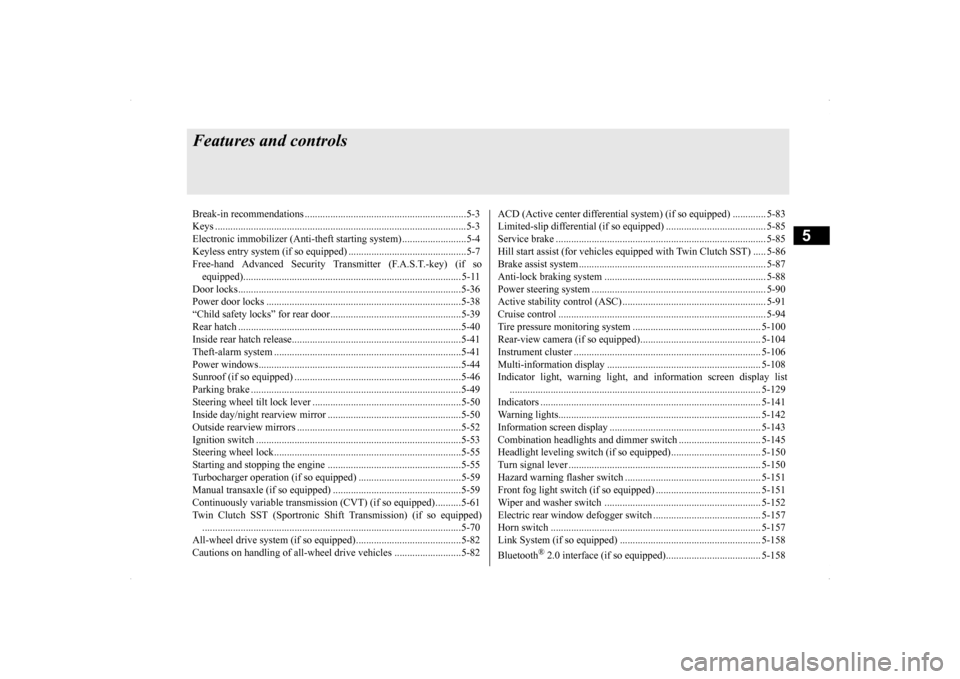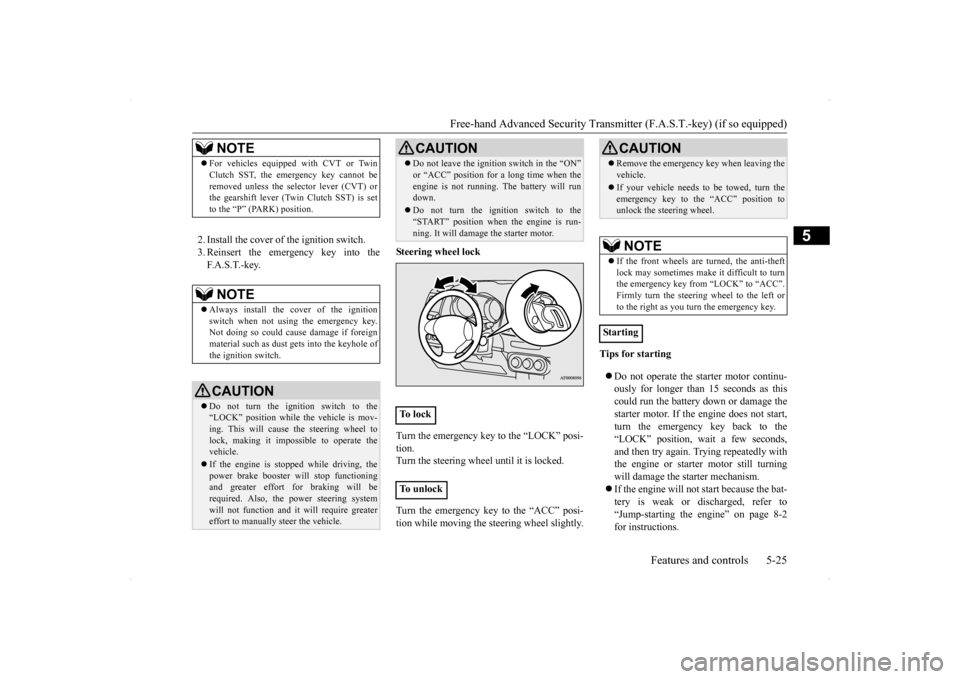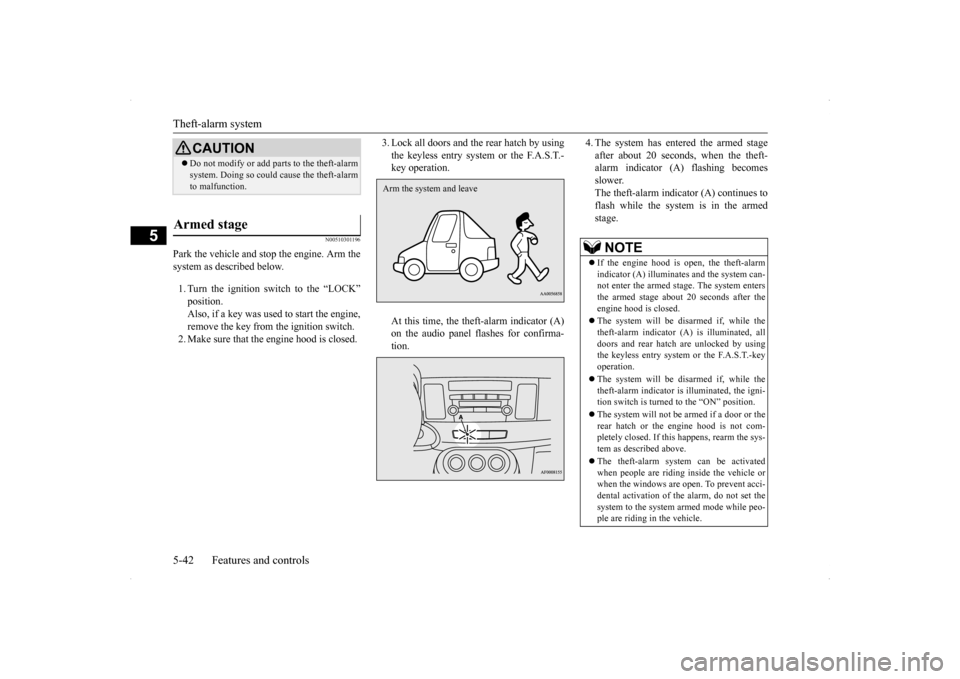2014 MITSUBISHI LANCER SPORTBACK stop start
[x] Cancel search: stop startPage 39 of 422

Seat belts 4-12 Seat and restraint systems
4
4. The lap part of the belt must always be worn low and snug across the hips. Pull up on the shoulder portion of the belt to take up any slack in the lap belt.
5. To release the belt, press the button on the buckle and allow the belt to retract. If the belt does not retract smoothly, pull itout and check for kinks or twists in the webbing. Then make sure it remains untwisted as it retracts.
N00409100011 N00409200025
Warning light
Warning display type 1 Warning display type 2 A tone and warning light are used to remind the driver to fasten the seat belt.If the ignition switch is turned to the “ON” position without the driver’s seat belt being fastened, a warning light will come on and atone will sound for approximately 6 seconds to remind you to fasten your seat belt. If you then drive with the seat belt unfastenedfor longer than a minute from when the igni- tion switch was turned on, the warning light will come on and blink repeatedly and thetone will sound intermittently.The warning light and the tone will stop after approximately 90 seconds. If you then repeatedly stop and start yourvehicle with the seat belt unfastened, the warning light/display and tone will remind you to fasten your seat belt every time thevehicle starts moving. You will also be
NOTE
With the exception of the seat belt for the driver, the seat belts in all other seating posi- tions are equipped with an Automatic Lock- ing Retractor (ALR) function. If you pull theseat belt fully out of the retractor, the retrac- tor will switch to its ALR child restraint installation function (see page 4-20).When the ALR function has been activated, the seat belt will only retract. If this happens, let the belt fully retract, then pull the seatbelt back out, repeating steps 1 through 4.
WA R N I N G Be sure the lap belt portion fits snugly and is worn as low as possible across the hips, not around the waist. Failure to follow this instruction will increase the risk of serious injury or death in the
event of an accident.
Be sure the seat belt webbing is not twisted when worn. Twisted webbing mayadversely affect seat belt performance.
Seat belt warning Driver’s seat belt reminder/warn- ing light and display
BK0200700US.bo
ok 12 ページ 2013年2月15日 金曜日 午後12時17分
Page 68 of 422

5
Features and controlsBreak-in recommendation
s ...............................................................5-3
Keys .....................................................
.............................................5-3
Electronic immobilizer (Anti-theft starting system) .........................5-4 Keyless entry system (if so equipped) ..............................................5-7Free-hand Advanced Security Transmitter (F.A.S.T.-key) (if so equipped)................................
..................................................... 5-11
Door locks........................
...............................................................5-36
Power door locks .............
...............................................................5-38
“Child safety locks” for
rear door...................................................5-39
Rear hatch ........................
...............................................................5-40
Inside rear hatch rel
ease................................
..................................5-41
Theft-alarm system ..........
...............................................................5-41
Power windows................
...............................................................5-44
Sunroof (if so equipped
) .........................................
........................5-46
Parking brake ...................
...............................................................5-49
Steering wheel tilt lock lever ..........................................................5-50Inside day/night rearview
mirror ....................................................5-50
Outside rearview mirr
ors ................................................................5-52
Ignition switch .................
...............................................................5-53
Steering wheel lock..........
...............................................................5-55
Starting and stopping the e
ngine ....................................................5-55
Turbocharger operation (if so equipped) ........................................5-59Manual transaxle (if so equipped) ..................................................5-59Continuously variable transmissi
on (CVT) (if so equipped)..........5-61
Twin Clutch SST (Sportronic Shif
t Transmission) (if so equipped)
...................................................................
..................................5-70
All-wheel drive system (if
so equipped).........................................5-82
Cautions on handling of all-wheel drive vehicles ..........................5-82
ACD (Active center differential system) (if so equipped) ............. 5-83 Limited-slip differential (i
f so equipped) ....................................... 5-85
Service brake ..................
.................................................
............... 5-85
Hill start assist (for vehicles equipped with Twin Clutch SST) ..... 5-86Brake assist system
................................................
......................... 5-87
Anti-lock braking syst
em ......................................
......................... 5-88
Power steering system
...........................................
......................... 5-90
Active stability control
(ASC) .....................
................................... 5-91
Cruise control .................
.................................................
............... 5-94
Tire pressure monitoring
system .................................................. 5-100
Rear-view camera (if so
equipped)..............
................................. 5-104
Instrument cluster .
.................................................
....................... 5-106
Multi-information disp
lay .....................................
....................... 5-108
Indicator light, warning light, and information screen display list
.................................................................
................................. 5-129
Indicators ..................................
.................................................... 5-141
Warning lights.................
.................................................
............. 5-142
Information screen disp
lay ....................................
....................... 5-143
Combination headlights and dimmer switch ................................ 5-145Headlight leveling switch (if
so equipped)................................... 5-150
Turn signal lever ...
.................................................
....................... 5-150
Hazard warning flasher
switch ..................................................... 5-151
Front fog light switch (if so
equipped) ......................................... 5-151
Wiper and washer swit
ch ......................................
....................... 5-152
Electric rear window def
ogger switch .......................................... 5-157
Horn switch ..............................
.................................................... 5-157
Link System (if so equi
pped) ....................................................... 5-158
Bluetooth
® 2.0 interface (if so
equipped)..................................... 5-158
BK0200700US.bo
ok 1 ページ 2013年2月15日 金曜日 午後12時17分
Page 84 of 422

Free-hand Advanced Security Transmit
ter (F.A.S.T.-key) (if so equipped)
Features and controls 5-17
5
N00513701090
Slowly turn the ignition switch to the “LOCK” position while pressing it. First, set the selector lever (CVT) or the gear- shift lever (Twin Clutch SST) to the “P” (PARK) position, and then slowly turn theignition switch to the “LOCK” position while pressing it.
N00503500203
With the F.A.S.T.-key, warnings are given through buzzers and displays on the informa-tion screen in the multi-information displayin order to prevent mistaken operations or vehicle theft. When a warning operates, be sure to checkthe vehicle and the F.A.S.T.-key. A warning is also displayed if there is a problem in the F. A . S . T. - k e y.If the following warning displays, contact an authorized Mitsubishi Motors dealer. If the following warning display, the display goes off if corrective action is taken.
NOTE
To turn the ignition switch from the “LOCK (PUSH OFF)” position to the “ACC” posi- tion, push the ignition switch again, turn the steering wheel in both directions and then turn the ignition switch. The ignition switch cannot be turned unless the F.A.S.T.-key is inside the vehicle.Refer to “Operating range for starting the engine” on page 5-14.
To turn from “ACC” to “LOCK”
For vehicles equipped with manual transaxle For vehicles equipped with continuously variable transmission (CVT) or Twin Clutch SST
NOTE
For vehicles equipped with CVT or Twin Clutch SST, the ignition switch cannot be turned to the “LOCK” position unless the selector lever (CVT) or the gearshift lever(Twin Clutch SST) is in the “P” (PARK) position.CAUTION If the engine is stopped while driving, the power brake booster will stop functioning and greater effort for braking will be required. Also, the power steering systemwill not function and it will require greater effort to manually steer the vehicle. Do not leave the ignition switch in the “ON” or “ACC” position for a long time when the engine is not running. Doing so could lead toa dead battery.
Do not turn the ignition switch to the “START” position when the engine is run- ning. It will damage the starter motor.
Warning activation
Type 1 Type 2
There is a problem in the F. A . S . T. - k e y
CAUTION
BK0200700US.bo
ok 17 ページ 2013年2月15日 金曜日 午後12時17分
Page 92 of 422

Free-hand Advanced Security Transmit
ter (F.A.S.T.-key) (if so equipped)
Features and controls 5-25
5
2. Install the cover of the ignition switch. 3. Reinsert the emergency key into theF. A . S . T. - k e y.
Steering wheel lock Turn the emergency key to the “LOCK” posi- tion. Turn the steering wheel until it is locked. Turn the emergency key to the “ACC” posi- tion while moving the steering wheel slightly.
Tips for starting Do not operate the starter motor continu- ously for longer than 15 seconds as this could run the battery down or damage the starter motor. If the engine does not start,turn the emergency key back to the “LOCK” position, wait a few seconds, and then try again. Trying repeatedly withthe engine or starter motor still turning will damage the starter mechanism. If the engine will not start because the bat- tery is weak or discharged, refer to “Jump-starting the engine” on page 8-2 for instructions.
NOTE
For vehicles equipped with CVT or Twin Clutch SST, the emergency key cannot be removed unless the selector lever (CVT) or the gearshift lever (Twin Clutch SST) is set to the “P” (PARK) position.NOTE
Always install the cover of the ignition switch when not using the emergency key. Not doing so could cause damage if foreignmaterial such as dust
gets into the keyhole of
the ignition switch.CAUTION Do not turn the ignition switch to the “LOCK” position while the vehicle is mov- ing. This will cause the steering wheel to lock, making it impossible to operate the vehicle. If the engine is stopped while driving, the power brake booster will stop functioning and greater effort for braking will berequired. Also, the power steering system will not function and it will require greater effort to manually steer the vehicle.
Do not leave the ignition switch in the “ON” or “ACC” position for a long time when the engine is not running. The battery will run down. Do not turn the ignition switch to the “START” position when the engine is run- ning. It will damage the starter motor.
To l o c k To u n l o c k
CAUTION
CAUTION Remove the emergency key when leaving the vehicle. If your vehicle needs to be towed, turn the emergency key to the “ACC” position tounlock the steering wheel.NOTE
If the front wheels are turned, the anti-theft lock may sometimes make it difficult to turnthe emergency key from “LOCK” to “ACC”. Firmly turn the steering wheel to the left or to the right as you turn the emergency key.
Starting
BK0200700US.bo
ok 25 ページ 2013年2月15日 金曜日 午後12時17分
Page 109 of 422

Theft-alarm system 5-42 Features and controls
5
N00510301196
Park the vehicle and stop the engine. Arm the system as described below. 1. Turn the ignition switch to the “LOCK” position. Also, if a key was used to start the engine, remove the key from the ignition switch.2. Make sure that the engine hood is closed.
3. Lock all doors and the rear hatch by using the keyless entry system or the F.A.S.T.- key operation. At this time, the theft-alarm indicator (A) on the audio panel flashes for confirma- tion.
4. The system has entered the armed stage after about 20 seconds, when the theft- alarm indicator (A) flashing becomes slower.The theft-alarm indicator (A) continues to flash while the system is in the armed stage.
CAUTION Do not modify or add parts to the theft-alarm system. Doing so could cause the theft-alarm to malfunction.
Armed stage
Arm the system and leave
NOTE
If the engine hood is open, the theft-alarm indicator (A) illuminates and the system can-not enter the armed stage. The system enters the armed stage about 20 seconds after the engine hood is closed. The system will be disarmed if, while the theft-alarm indicator (A) is illuminated, alldoors and rear hatch are unlocked by using the keyless entry system or the F.A.S.T.-key operation. The system will be disarmed if, while the theft-alarm indicator is illuminated, the igni-tion switch is turned to the “ON” position. The system will not be
armed if a door or the
rear hatch or the engine hood is not com- pletely closed. If this happens, rearm the sys- tem as described above. The theft-alarm system can be activated when people are riding inside the vehicle or when the windows are open. To prevent acci- dental activation of the alarm, do not set thesystem to the system armed mode while peo- ple are riding in the vehicle.
BK0200700US.bo
ok 42 ページ 2013年2月15日 金曜日 午後12時17分
Page 122 of 422
![MITSUBISHI LANCER SPORTBACK 2014 8.G Owners Manual Steering wheel lock
Features and controls 5-55
5
N00512500179
[For vehicles equipped with the F.A.S.T.- key]For information on operations for vehicles equipped with the F.A.S.T.-key, refer to “F.A. MITSUBISHI LANCER SPORTBACK 2014 8.G Owners Manual Steering wheel lock
Features and controls 5-55
5
N00512500179
[For vehicles equipped with the F.A.S.T.- key]For information on operations for vehicles equipped with the F.A.S.T.-key, refer to “F.A.](/manual-img/19/7508/w960_7508-121.png)
Steering wheel lock
Features and controls 5-55
5
N00512500179
[For vehicles equipped with the F.A.S.T.- key]For information on operations for vehicles equipped with the F.A.S.T.-key, refer to “F.A.S.T.-key: Steering wheel lock” on page5-20. [Except for vehicles equipped with the F. A . S . T. - k e y ]
Remove the key at the “LOCK” position. Turn the steering wheel until it is locked. Turn the key to the “ACC” position while moving the steering wheel slightly.
N00542100057
Do not operate the starter motor continu- ously for longer than 15 seconds as thiscould run the battery down or damage the starter motor. If the engine does not start, turn the ignition switch back to the“LOCK” position, wait a few seconds, and then try again. Trying repeatedly with the engine or starter motor still turningwill damage the starter mechanism. If the engine will not start because the bat- tery is weak or discharged, refer to“Jump-starting the engine” (on page 8-2) for instructions.
If the engine is turned off while driving, the power brake booster will stop functioning and braking efficiency will be reduced. Also, the power steering system will not function and it will require greater effort to manuallysteer the vehicle. Do not leave the key in the “ON” position for a long time when the engine is not running. This will cause the battery to run down. Do not turn the key to the “START” position when the engine is running. It will damage the starter motor.
Steering wheel lock
CAUTION
To l o c k To u n l o c k
CAUTION Remove the key when leaving the vehicle.
NOTE
If the front wheels are turned, the anti-theft lock may sometimes make it difficult to turn the key from “LOCK” position to “ACC” position. Firmly turn the steering wheel to the left or to the right as you turn the key.
Starting and stopping the engine Tips for starting
BK0200700US.bo
ok 55 ページ 2013年2月15日 金曜日 午後12時17分
Page 123 of 422
![MITSUBISHI LANCER SPORTBACK 2014 8.G Owners Manual Starting and stopping the engine 5-56 Features and controls
5
[Except for vehicles equipped with the turbocharger] The engine is warmed up enough for driv- ing when the bar graph of engine coolant MITSUBISHI LANCER SPORTBACK 2014 8.G Owners Manual Starting and stopping the engine 5-56 Features and controls
5
[Except for vehicles equipped with the turbocharger] The engine is warmed up enough for driv- ing when the bar graph of engine coolant](/manual-img/19/7508/w960_7508-122.png)
Starting and stopping the engine 5-56 Features and controls
5
[Except for vehicles equipped with the turbocharger] The engine is warmed up enough for driv- ing when the bar graph of engine coolanttemperature display starts to move. A lon- ger warm up period will only consume extra fuel. [For vehicles equipped with the turbo- charger] The engine is warmed up enough for driv-ing when the bar graph of engine coolanttemperature display starts to move. Driv- ing before the bar graph moves may cause deterioration of turbocharger performanceand driveability. A longer warm up period will only consume extra fuel. On vehicles equipped with the Twin Clutch SST, the following may occur after the engine is started, but they do not indi- cate an abnormality.• You may hear operational sounds of the Twin Clutch SST and you may feel vibration in the vehicle body.• If you shift the gearshift lever into the “N” (NEUTRAL) position and depress the accelerator pedal, increases in theengine speed will be limited.
N00542200159
[For vehicles equipped with the F.A.S.T.-key]For information on operation for vehicles equipped with the F.A.S.T.-key, refer to “F.A.S.T.-key: Starting the engine” on page5-20. [Except for vehicles equipped with the F. A . S . T. - k e y ] Your vehicle is equipped with an electroni-cally controlled fuel injection system, which
automatically controls the release of fuel. There is usually no need to depress the accel- erator pedal when starting the engine. The starter should not be run for more than 15seconds at a time. To prevent battery drain, wait a few seconds between attempts to restart the engine. 1. Make sure all occupants are properly seated with seat belts fastened. 2. Insert the ignition key. 3. Make sure the parking brake is applied.4. Press and hold the brake pedal down withyour right foot. 5. Press and hold the clutch pedal all the way down (manual transaxle).
WA R N I N G Never run the engine in a closed or poorly ventilated area any longer than is needed to move your vehicle out of the area. Car- bon monoxide gas, which is odorless and extremely poisonous, could build up andcause serious injury or death.CAUTION Do not push-start the vehicle.Do not run the engine
at high rpms or drive
at high speeds until the engine has had a chance to warm up. Release the ignition switch as soon as the engine starts. Otherwise, the starter motorwill be damaged.
Starting the engine
NOTE
For models equipped with a manual trans- axle, the starter will
not operate unless the
clutch pedal is fully depressed (Clutch inter-lock). This is a safety feature.
BK0200700US.bo
ok 56 ページ 2013年2月15日 金曜日 午後12時17分
Page 124 of 422

Starting and stopping the engine Features and controls 5-57
5
6. On vehicles equipped with manual trans- axle, place the gearshift lever in the “N” (Neutral) position. On vehicles equipped with continuouslyvariable transmission (CVT) or Twin Clutch SST, make sure the selector lever (CVT) or the gearshift lever (Twin ClutchSST) is in the “P” (PARK) position. 7. Turn the ignition switch to the “ON” posi- tion and make certain that all warning lights are functioning properly before starting the engine.
8. Turn the ignition switch to the “START” position without pressing the accelerator pedal. Release the key when the engine starts.
After several attempts, you may experience that the engine still does not start. 1. Make sure that all electric devices, such as lights, air conditioning blower and rearwindow defogger, are turned off. 2. While depressing the brake pedal on vehi- cles equipped with continuously variabletransmission (CVT) or the clutch pedal on the vehicles equipped with manual trans- axle, press the accelerator pedal halfwayand hold it there, then crank the engine. Release the accelerator pedal, immedi- ately after the engine starts.
3. If the engine still will not start, the engine could be flooded with too much gasoline. While depressing the brake pedal on vehi- cles equipped with CVT or the clutchpedal on the vehicles equipped with man- ual transaxle, push the accelerator pedal all the way down and hold it there, thencrank the engine for 5 to 6 seconds. Return the ignition switch to the “LOCK” position and release the accelerator pedal.Wait a few seconds, and then crank theengine again for 5 to 6 seconds while depressing the brake pedal or the clutch pedal, but do not push the acceleratorpedal. Release the ignition key if the engine starts. If the engine fails to start, repeat these procedures. If the engine stillwill not start, contact your local Mitsubi- shi Motors dealer or a repair facility of your choice for assistance.
When the ambient temperature is -4 °F (-20 °C) or lower on vehicles equipped with CVT, -22 °F (-30 °C) or lower on vehicles equippedwith Twin Clutch SST, it may not be possible
NOTE
On vehicles equipped with CVT, the starter will not operate unless the selector lever is inthe “P” (PARK) or “N” (NEUTRAL) posi- tion. On vehicles equipped with Twin Clutch SST,the starter will not operate unless the gear- shift lever is in the “P” (PARK) position or the gearshift lever is in the “N” (NEUTRAL)position with the brake pedal depressed. For safety reasons, start the engine in the “P” (PARK) position so that the wheels arelocked.
NOTE
Minor noises may be heard on engine start- up. These will disappear as the engine warms up.
When the engine is hard to start
Startability of continuously vari- able transmission (CVT) vehicles or Twin Clutch SST vehicles at extremely cold ambient tempera- ture
BK0200700US.bo
ok 57 ページ 2013年2月15日 金曜日 午後12時17分